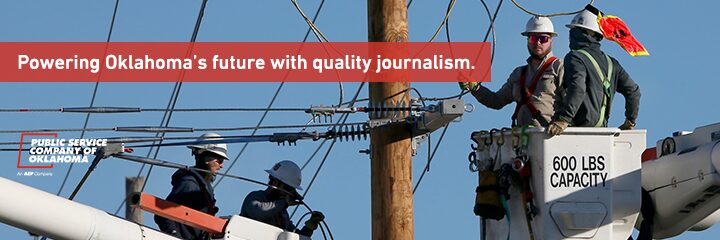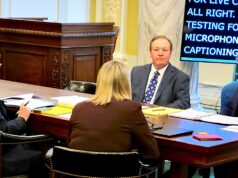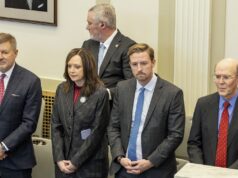
In my adulthood, I have attended many public meetings and dug many nuggets of truth from the banks of complex civic process. Still, the Oklahoma Corporation Commission’s “net loss revenue” ruling on OG&E’s SmartHours program is complicated enough to make my brain hurt.
It’s made other people enraged, but in the end it might not even be that big of a deal.
SmartHours ruling background
On Aug. 17, NewsOK reporter and resident Scotsman Paul Monies wrote of the previous day’s unanimous Corp Comm vote to approve a settlement regarding the company’s “lost revenue” from operating SmartHours, a program intended to save the system and participating customers money by incentivizing off-peak electricity usage. (Don’t run that load of laundry from 2 p.m. to 7 p.m., for example, and save on your bill as a result.)
From Monies’ report:
OG&E will recover $30.3 million — $10.1 million per year — for three years of lost revenue from SmartHours from 2013 to 2015. The utility contended the annual amount was more than $11 million.
Under Corporation Commission rules, OG&E and other utilities get to recover “lost net revenues” for demand-response and energy-efficiency programs. The reimbursements — which come from customers as part of a temporary “rider” on bills — are designed to be an incentive for utilities to offer the programs.
The settlement among the utility, the commission’s public utility division and the OG&E Shareholders Association resolves a dispute in calculating the amount of lost revenue under SmartHours. The public utility division said the annual amount was closer to $5 million.
Three days later, NewsOK published a letter to the editor from Sharon Gricol of McLoud who took issue with the ruling as she interpreted it from Monies’ report:
We participate in the SmartHours program. This program was encouraged by OG&E for its customers to help them save money on their electric bills and to help ease energy use during peak hours of use. The customers were happy to save money and OG&E was happy with the usage reduction. Now OG&E has been awarded a $30.3 million settlement for lost revenues over the past three years. The reimbursements will come from the customers. The money we saved will now be collected in a “temporary rider” tacked onto our bills.
How about that? We saved money by doing as we were encouraged to do by OG&E, and it lost revenue so it’s going to take our savings from us. This is wrong.
Gricol’s brief comments summarized the feelings of people who called me on the topic as well, only she did it without cussing. Others reacted with pure outrage, damning the utility for promoting savings on one hand while pilfering the nickels out of your jean shorts with the other.
One man texted:
“I love when the state’s main energy provider does something so unethical and absurd that when you tell people about the ‘SmartHours situation,’ their immediate response is, ‘That can’t be real,’ seconded by, ‘If I don’t have SmartHours, do I still have to pay?”
Gotta be plenty smart to understand SmartHours
In reality, it doesn’t appear OG&E is “going to take our savings from us,” as Gricol wrote in her letter. At least not in any major way that results in more than $1 extra per month on the bill “rider.” (Which won’t really be “new” for customers. See below.)
But Gricol and others’ interpretation of the situation is understandable and not factually wrong, at least by any explanation I can find.
And therein lies the problem. Finding an explanation for how this SmartHours situation will play out has been tougher than finding bonus points in a credit card statement.
Monies’ story barely scratches the surface of this settlement’s details, and 40 minutes of discussion last week with Joe Briley — OCC Chairman Bob Anthony’s chief of staff — left me more confused than ever before. I asked Briley then and again by phone Monday to email more details about the settlement, but he did not.
I emailed OG&E senior communications specialist Karen Kurtz and asked a couple of questions about the situation. In addition to providing answers, she posted the company’s explanation of “loss net revenue” online for the public to view.
“Customers are not paying back to OG&E what they saved with SmartHours or other energy efficiency programs and will not see an increase in their bills as part of this settlement,” the explanation notes in bold and italics.
Cue the spit take.
It turns out that the “Demand Rider Program” has already been factored into OG&E bills since 2015, according to Kurtz. That’s the company’s explanation for how customer bills won’t be going up.
Kurtz said in a statement:
Over the last several years over 99 percent of our customers have saved money on the SmartHours program. Over that same time, the average savings for a customer on the program was $150. Customers on the program have given OG&E high marks in the area of customer satisfaction, and the program offers customers total control on their savings and their comfort. OG&E has been recognized by other utilities and industry associations as having one of the most successful demand reduction programs in the nation.
Successful or not, the SmartHours program and its net-loss revenue ruling highlight how behind the eight ball consumers are in understanding what they pay and how or why they pay it. For instance, this “rider” that customers have supposedly been paying since 2015 is not itemized on OG&E bills, nor on OG&E SmartHours reports.
It can, however, be found here online. Customers can see all Oklahoma rate tariffs here.
Still, in the future, this is the sort of complex industry/government agreement that both parties — and media — need to explain better for the public.
(Editor’s Note: The author is an OG&E customer and a SmartHours participant who “saved” $12.17 last month according to his SmartHours report.)
More on the Oklahoma Corporation Commission
More recess: On enormous rate case, Todd Hiett states position before further delay





















